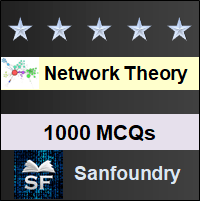
Network Theory Multiple Choice Questions Highlights
- 1000+ Multiple Choice Questions & Answers (MCQs) in Network Theory with a detailed explanation of every question.- These MCQs cover theoretical concepts, true-false(T/F) statements, fill-in-the-blanks and match the following style statements.
- These MCQs also cover numericals as well as diagram oriented MCQs.
- These MCQs are organized chapterwise and each Chapter is futher organized topicwise.
- Every MCQ set focuses on a specific topic of a given Chapter in Network Theory Subject.
Who should Practice Network Theory MCQs?
– Students who are preparing for college tests and exams such as mid-term tests and semester tests on Network Theory.- Students who are preparing for Online/Offline Tests/Contests in Network Theory.
– Students who wish to sharpen their knowledge of Network Theory Subject.
- Anyone preparing for Aptitude test in Network Theory.
- Anyone preparing for interviews (campus/off-campus interviews, walk-in interview and company interviews).
- Anyone preparing for entrance examinations and other competitive examinations.
- All - Experienced, Freshers and College / School Students.
Network Theory Chapters
Here's the list of chapters on the "Network Theory" subject covering 100+ topics. You can practice the MCQs chapter by chapter starting from the 1st chapter or you can jump to any chapter of your choice.- Circuit Elements and Kirchhoff’s Laws
- Methods of Analyzing Circuits
- Useful Theorems in Circuit Analysis
- Introduction to Alternating Currents and Voltages
- Complex Impedence
- Power and Power Factor
- Steady State AC Analysis
- Resonance & Magnetically Coupled Circuit
- Polyphase Circuits
- Transients
- Intoduction to the Laplace Transform
- Application of the Laplace Transform in Circuit Analysis
- S-Domain Analysis
- Two-Port Networks
- Filters and Attenuators
- Elements of Realizability and Synthesis of One-Port Networks
- Network Theory and Complex Circuit Diagram
1. Circuit Elements and Kirchhoff’s Laws
The section contains multiple choice questions and answers on basic network concepts, defintions and sources, circuit elements, kirchhoffs current and voltage law.
|
|
|
2. Methods of Analyzing Circuits
The section contains questions and answers on tree, tie-set matrix, tree branch voltages, mesh and supermesh analysis, nodal and supernode analysis.
|
|
|
3. Useful Theorems in Circuit Analysis
The section contains MCQs on star delta transformation, superposition and thevenins theorem, nortons, reciprocity and compensation theorem, maximum power transfer theorem, tellegens and millmans theorem, advanced problems on superposition theorem, reciprocity theorem, millman’s and network theorems.
4. Introduction to Alternating Currents and Voltages
The section contains multiple choice questions and answers on sine waves, pure resistors, voltage and current values of sine waves.
|
|
|
5. Complex Impedence
The section contains questions and answers on impedence diagram, series and parallel circuits.
|
|
|
6. Power and Power Factor
The section contains MCQs on instantaneous and average power, apparent power and reactive power.
|
|
|
7. Steady State AC Analysis
The section contains multiple choice questions and answers on mesh and nodal analysis, nortons, transfer, superposition and thevenins theorem.
|
|
|
8. Resonance & Magnetically Coupled Circuit
The section contains questions and answers on series and parallel resonance, tank circuit and rlc circuit bandwidth, series and parallel resonance problems, dot convention and copuling coefficient problems, advanced problems on resonance and magnetically coupled circuits.
9. Polyphase Circuits
The section contains MCQs on polyphase system, star connected systems, star to delta transformation, three phase balanced and unbalanced circuits, three phase circuits power measurement.
10. Transients
The section contains mulitple choice questions and answers on dc and sinusodial response of r-l, r-c, r-l-c circuits.
11. Intoduction to the Laplace Transform
The section contains questions and answers on laplace transform, operational and inverse transforms.
|
|
|
12. Application of the Laplace Transform in Circuit Analysis
The section contains MCQs on circuit elements in s domain, transfer and impulse function. problems on standard time function, initial and final value theorem, advanced problems on laplace transform and its applications.
13. S-Domain Analysis
The section contains multiple choice questions and answers on complex frequency, series and parallel combinations, poles and zeros of network functions, driving point and transfer functions.
14. Two-Port Networks
The section contains questions and answers on open and short circuit impedence, different parameters, two port networks and image parameters, hybrid and inverse hybrid parameters, parameters relationships, two port network inter connection, terminated two port network, advanced problems on two port network, transmission and hybrid parameters relation with short & open circuit impedance parameters.
15. Filters and Attenuators
The section contains MCQs on filter networks, pass and stop band, attenuators, k low pass filters, inverse network, advanced problems on filters, series and shunt equalizer.
16. Elements of Realizability and Synthesis of One-Port Networks
The section contains multiple choice questions and answers on hurwitz polynomials, reactive one port responses bt fosters and cauer methods, r-l, r-c networks by foster and cauer methods.
17. Network Theory and Complex Circuit Diagram
The section contains questions and answers on network theory and complex circuit diagram advanced problems.
|
|
|
Wish you the best in your endeavor to learn and master Network Theory!
